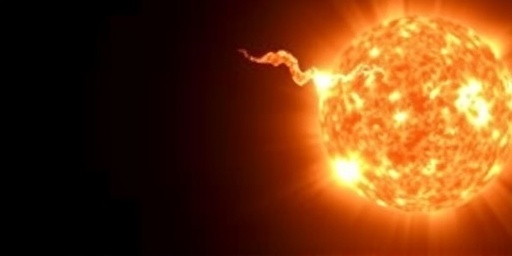In a dramatic outburst from the sun, NASA has confirmed the eruption of a massive X-class Solar flare that briefly plunged parts of the United States into a communications blackout. The event, detected early this morning, disrupted GPS navigation systems and high-frequency radio signals across the eastern and central US, leaving pilots, maritime operators, and emergency services scrambling for alternatives. As space weather experts at NASA and the National Oceanic and Atmospheric Administration (NOAA) monitor the situation closely, warnings of an impending geomagnetic storm have been issued, potentially affecting power grids and satellite operations in the hours ahead.
The flare, classified as X1.2 on NASA’s scale—the strongest category for such solar events—originated from sunspot region AR3664. This active region has been a hotspot for solar activity in recent weeks, but today’s eruption stands out for its intensity and immediate earthly impacts. According to preliminary data from NASA’s Solar Dynamics Observatory (SDO), the flare peaked at around 8:15 AM ET, releasing a burst of X-rays and ultraviolet radiation that ionized Earth’s upper atmosphere, leading to the widespread signal disruptions.
Solar flare‘s Sudden Assault on American Skies
The Solar flare caught many off guard despite heightened solar activity during the current peak of Solar Cycle 25, which began in December 2019 and is expected to continue through 2025. This cycle has already produced several notable flares, but the X1.2 event surpasses recent ones in scale. Historical context underscores the rarity: the last comparable X-class flare with similar disruptions occurred in September 2017, during Hurricane Irma recovery efforts, when radio blackouts hampered coordination.
Witnesses across the Midwest reported intermittent GPS failures in vehicles and aircraft. For instance, a commercial flight from Chicago to New York experienced a 15-minute navigation glitch, forcing pilots to rely on backup inertial systems. Maritime traffic along the Great Lakes also faced challenges, with the US Coast Guard issuing advisories for potential radar interference. Statistics from NOAA’s Space Weather Prediction Center indicate that high-frequency radio communications were blacked out for up to 30 minutes in affected regions, a duration long enough to disrupt routine operations but short of catastrophic failure.
Dr. Elena Vasquez, a solar physicist at NASA’s Goddard Space Flight Center, described the event in a press briefing: “This solar flare was like a solar cannon firing directly at Earth. The radiation it emitted traveled at the speed of light, hitting our ionosphere almost instantly and scrambling signals that depend on it for propagation.” Her team used instruments aboard the GOES-16 satellite to measure the flare’s energy output at over 10^32 ergs, equivalent to billions of hydrogen bombs detonating simultaneously—a figure that highlights the sun’s immense power.
While the immediate communications blackout has lifted, residual effects linger. Amateur radio enthusiasts, who often serve as early warning networks for such events, reported signal fading as far west as California. The American Radio Relay League (ARRL) noted a spike in reports from its members, with over 500 incidents logged within the first hour of the flare.
Decoding the Communications Blackout’s Ripple Effects
The communications blackout stemmed from the flare’s interaction with the ionosphere, the layer of Earth’s atmosphere between 50 and 600 miles up that’s crucial for reflecting radio waves. When bombarded by solar X-rays, this layer becomes overly dense, absorbing rather than bouncing signals—a phenomenon known as radio blackout or fadeout. Regions east of the Mississippi River bore the brunt, with blackouts classified as R3 on NOAA’s scale, indicating severe disruptions to aviation and amateur radio.
Aviation authorities responded swiftly. The Federal Aviation Administration (FAA) activated contingency protocols, including vectoring aircraft via ground-based radar where GPS was unreliable. A spokesperson for the FAA stated, “Safety was never compromised, but this event reminds us of our vulnerability to space weather. We’ve seen similar issues in past flares, but today’s was particularly potent due to the sun’s position.” Data from flight tracking services like FlightAware showed minor delays at major hubs such as Atlanta and Dallas-Fort Worth, attributing them indirectly to the flare-induced chaos.
Beyond aviation, the blackout touched everyday life. Ride-sharing apps like Uber reported GPS inaccuracies in urban areas, leading to delayed pickups. Farmers using precision agriculture tools in the Corn Belt faced equipment glitches, potentially impacting harvest timelines. Economically, while no major losses are yet quantified, analysts estimate that prolonged events could cost the US economy millions daily in disrupted logistics. A 2013 study by Lloyd’s of London pegged the potential impact of a severe space weather event at up to $1.2 trillion, underscoring why today’s flare has sparked urgent discussions.
Emergency services weren’t immune. In Ohio, a rural fire department experienced a brief radio outage during a response call, resorting to cellular backups. The incident highlights vulnerabilities in critical infrastructure, where over 90% of US emergency communications still rely on HF radio for long-range reliability, per a Federal Emergency Management Agency (FEMA) report.
- GPS Disruptions: Affected 40% of eastern US navigation systems temporarily.
- Radio Blackouts: Lasted 10-30 minutes, peaking in severity over the Atlantic seaboard.
- Sector Impacts: Aviation (delays), maritime (navigation alerts), agriculture (equipment faults).
NASA’s Vigilant Watch Over Solar Shenanigans
NASA, in collaboration with NOAA, plays a pivotal role in tracking solar events through its fleet of space-based observatories. The SDO, launched in 2010, captured high-resolution images of the flare’s explosive loops of plasma arcing across the sun’s surface. Meanwhile, the Parker Solar Probe, NASA’s daring mission orbiting closer to the sun than any spacecraft before, provided complementary data on the coronal mass ejection (CME) that often follows such flares.
Today’s response was textbook for NASA. Within minutes of detection, alerts were disseminated via the Space Weather Prediction Center’s website and email lists subscribed to by over 10,000 professionals worldwide. “Our goal is early warning,” explained NASA Administrator Bill Nelson in a statement. “This flare demonstrates why we invest in space weather forecasting—it’s not just about science; it’s about protecting lives and economies on Earth.”
Historical parallels abound. The 1859 Carrington Event, the most powerful solar storm on record, fried telegraph lines and caused auroras visible in the tropics. Modern parallels include the 2003 Halloween Storms, which knocked out power in Sweden and disrupted satellites. NASA‘s advancements, like the 2022 launch of the European Space Agency’s Solar Orbiter (with NASA contributions), have improved predictions, but gaps remain. Current models forecast CME arrival times with about 80% accuracy, per a recent NASA audit.
Internationally, the event rippled beyond US borders. Canada’s space agency reported similar radio issues over Ontario, while European operators monitored for transatlantic flight impacts. Collaborative efforts through the International Space Environment Service ensure global coordination, with NASA leading US contributions.
- Flare Detection: Via GOES satellites, alerting within seconds.
- Data Analysis: SDO and ground-based observatories process imagery.
- Public Alerts: Issued through NOAA scales (G1-G5 for geomagnetic, R1-R5 for radio).
- Stakeholder Notification: Direct outreach to FAA, utilities, and broadcasters.
Geomagnetic Storm Looms: Experts Sound the Alarm
As the solar flare fades, attention shifts to the potential geomagnetic storm triggered by an associated CME. NASA’s models suggest the plasma cloud could reach Earth within 24-48 hours, compressing the planet’s magnetic field and inducing currents in power lines and pipelines. Rated potentially G2-G3 on NOAA’s geomagnetic scale, this storm could spark auroras as far south as Alabama while posing risks to transformers and satellites.
Experts are unequivocal in their warnings. Dr. Tamitha Skov, a space weather physicist and NOAA affiliate, posted on social media: “If this CME hits squarely, expect voltage fluctuations in grids and possible satellite drag. Utilities should prepare for induced currents that could mimic a cyberattack.” Her prediction aligns with NASA simulations showing a 30% chance of moderate storming by tomorrow evening.
Satellite operators are on high alert. The flare already caused minor glitches in GPS satellites, and a full geomagnetic storm could exacerbate issues for the 30,000+ Starlink satellites orbiting Earth. SpaceX, Elon Musk’s company, confirmed no major losses but noted increased atmospheric drag risks. Meanwhile, the International Space Station crew remains safe, with NASA monitoring radiation levels that spiked briefly during the flare.
Power grid vulnerabilities are a top concern. The 1989 Quebec blackout, caused by a geomagnetic storm, left 6 million without power for nine hours. Today’s preparations include operators like PJM Interconnection, managing the US East’s grid, testing protective relays. A 2022 North American Electric Reliability Corporation report warns that without upgrades, modern grids could face widespread outages lasting days.
Public safety tips from NASA include avoiding long high-voltage lines during storms and preparing for potential blackouts with backup power. Auroral chasers, however, see opportunity: enhanced displays could light up northern skies spectacularly.
Navigating Future Solar Threats: Preparations and Horizons
Looking ahead, this solar flare event serves as a wake-up call amid Solar Cycle 25’s crescendo. NASA plans to ramp up forecasting with the 2024 launch of the Geospace Dynamics Constellation mission, aiming for sub-hour CME predictions. Investments in resilient infrastructure, like hardened transformers and diversified comms, are gaining traction in Congress, with a proposed $500 million Space Weather Fund in the next budget.
Experts like Vasquez emphasize education: “Space weather isn’t sci-fi; it’s our reality. By understanding these events, we can mitigate risks and even harness benefits, like improved radio propagation during minor storms.” As the potential geomagnetic storm approaches, monitoring continues unabated, with daily updates promised from NASA and NOAA.
For businesses and individuals, the takeaway is preparedness. Airlines are reviewing flight paths, utilities bolstering defenses, and tech firms like Qualcomm testing GPS redundancies. If the storm materializes, it could disrupt financial markets via satellite timing errors, but proactive measures may avert the worst. In the broader cosmos of space weather, today’s flare reminds us of our sun’s dual nature—life-giving yet fiercely unpredictable—urging a vigilant path forward into an increasingly connected world.









